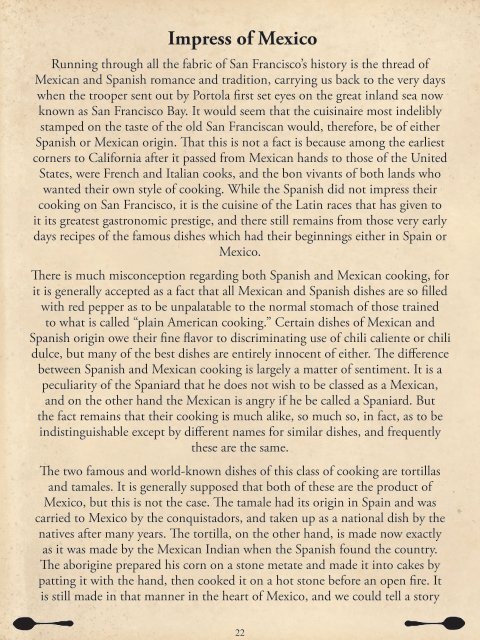The Elegant Art of Dining: Bohemian San Francisco, Its ... - iMedia
The Elegant Art of Dining: Bohemian San Francisco, Its ... - iMedia
The Elegant Art of Dining: Bohemian San Francisco, Its ... - iMedia
Create successful ePaper yourself
Turn your PDF publications into a flip-book with our unique Google optimized e-Paper software.
Impress <strong>of</strong> Mexico<br />
Running through all the fabric <strong>of</strong> <strong>San</strong> <strong>Francisco</strong>’s history is the thread <strong>of</strong><br />
Mexican and Spanish romance and tradition, carrying us back to the very days<br />
when the trooper sent out by Portola first set eyes on the great inland sea now<br />
known as <strong>San</strong> <strong>Francisco</strong> Bay. It would seem that the cuisinaire most indelibly<br />
stamped on the taste <strong>of</strong> the old <strong>San</strong> Franciscan would, therefore, be <strong>of</strong> either<br />
Spanish or Mexican origin. That this is not a fact is because among the earliest<br />
corners to California after it passed from Mexican hands to those <strong>of</strong> the United<br />
States, were French and Italian cooks, and the bon vivants <strong>of</strong> both lands who<br />
wanted their own style <strong>of</strong> cooking. While the Spanish did not impress their<br />
cooking on <strong>San</strong> <strong>Francisco</strong>, it is the cuisine <strong>of</strong> the Latin races that has given to<br />
it its greatest gastronomic prestige, and there still remains from those very early<br />
days recipes <strong>of</strong> the famous dishes which had their beginnings either in Spain or<br />
Mexico.<br />
<strong>The</strong>re is much misconception regarding both Spanish and Mexican cooking, for<br />
it is generally accepted as a fact that all Mexican and Spanish dishes are so filled<br />
with red pepper as to be unpalatable to the normal stomach <strong>of</strong> those trained<br />
to what is called “plain American cooking.” Certain dishes <strong>of</strong> Mexican and<br />
Spanish origin owe their fine flavor to discriminating use <strong>of</strong> chili caliente or chili<br />
dulce, but many <strong>of</strong> the best dishes are entirely innocent <strong>of</strong> either. <strong>The</strong> difference<br />
between Spanish and Mexican cooking is largely a matter <strong>of</strong> sentiment. It is a<br />
peculiarity <strong>of</strong> the Spaniard that he does not wish to be classed as a Mexican,<br />
and on the other hand the Mexican is angry if he be called a Spaniard. But<br />
the fact remains that their cooking is much alike, so much so, in fact, as to be<br />
indistinguishable except by different names for similar dishes, and frequently<br />
these are the same.<br />
<strong>The</strong> two famous and world-known dishes <strong>of</strong> this class <strong>of</strong> cooking are tortillas<br />
and tamales. It is generally supposed that both <strong>of</strong> these are the product <strong>of</strong><br />
Mexico, but this is not the case. <strong>The</strong> tamale had its origin in Spain and was<br />
carried to Mexico by the conquistadors, and taken up as a national dish by the<br />
natives after many years. <strong>The</strong> tortilla, on the other hand, is made now exactly<br />
as it was made by the Mexican Indian when the Spanish found the country.<br />
<strong>The</strong> aborigine prepared his corn on a stone metate and made it into cakes by<br />
patting it with the hand, then cooked it on a hot stone before an open fire. It<br />
is still made in that manner in the heart <strong>of</strong> Mexico, and we could tell a story<br />
22





